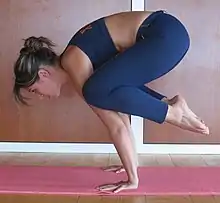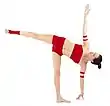Bakasana
Bakasana (Crane pose), and the similar Kakasana (Crow pose) are balancing asanas in hatha yoga and modern yoga as exercise.[1] In all variations, these are arm balancing poses in which hands are planted on the floor, shins rest upon upper arms, and feet lift up. The poses are often confused, but traditionally Kakasana has arms bent, Bakasana (the crane being the taller bird with longer legs) has the arms straight.[2]

Etymology and origins
The names for the asanas come from the Sanskrit words बक baka ("crane") or काक kāka ("crow"), and आसन āsana meaning "posture" or "seat".[3][4]
While different yoga lineages use one name or another for the asanas, Dharma Mittra makes a distinction, citing Kakasana as being with arms bent (like the shorter legs of a crow) and Bakasana with arms straight (like the longer legs of a crane).[5] B. K. S. Iyengar's 1966 Light on Yoga describes only Bakasana, with straight arms.[6] In Sivananda Yoga, Swami Vishnudevananda's 1960 Complete Illustrated Book of Yoga describes only Kakasana, with bent arms.[7] However, practitioners in the west often mistranslate the Sanskrit "Bakasana" as "Crow Pose".[2][8]
These balancing poses can be dated at least to the 17th century Hatha Ratnavali, where Bakasana is number 62 of the 84 poses said to have been taught by Shiva.
The 19th century Sritattvanidhi describes and illustrates both Kakasana and Bakasana.[10]
In his 1969 book Asana Pranayama Mudra Bandha, Swami Satyananda Saraswati of the Bihar School of Yoga uses the name Bakasana for a different pose entirely (Dandayamana Janushirsasana, pose 5 in Bikram Yoga), standing on one leg, the body angled down with the other leg straight out in line with the body, the arms straight and grasping the standing big toe.[11]
Description
.jpg.webp)
These asanas are arm balances. According to B.K.S. Iyengar there are two techniques for entering them. The simple method is by pushing up from a crouching position. The advanced method is to drop down from Shirshasana (yoga headstand).[6]
Variations
Asymmetric variations include:
Follow-up asanas
Crane/Crow is often followed by Chaturanga Dandasana (Four-Limbed Staff Pose) or Salamba Sirsasana II (Supported Head Stand, Second version). Some practitioners jump in and out of Crane/Crow via Adho Mukha Svanasana (Downward-Facing Dog Pose).
Claims
Twentieth century advocates of some schools of yoga, such as B. K. S. Iyengar, made claims for the effects of yoga on specific organs, without adducing any evidence.[15][16] Iyengar claimed that this pose "strengthens the arms and abdominal organs since the latter are contracted."[17]
See also
- Bhujapidasana – a similar hand-balancing pose, with the feet crossed in front of the body
- Tittibhasana - a hand-balancing pose with the feet stretched straight out in front
References
- "Crane Pose". Yoga Journal. Retrieved 9 April 2011.
- Belling, Noa (20 February 2008). The Yoga Handbook. New Holland Publishers. p. 159. ISBN 978-1-84537-935-3.
- Sinha, S. C. (1996). Dictionary of Philosophy. Anmol Publications. p. 18. ISBN 978-81-7041-293-9.
- Kingsland, Kevin; Kingsland, Venika (1976). Complete Hatha Yoga. Arco. p. 121. ISBN 978-0-668-03958-1.
- Mittra, Dharma (21 March 2003). Asanas: 608 Yoga Postures. New World Library. ISBN 978-1-57731-402-8. Retrieved 25 June 2011.
- Iyengar, B. K. S. (1987) [1966]. Light on Yoga. New York: Schocken Books. pp. 315–317. ISBN 0-8052-0610-8.
- Vishnu-devananda, Swami (1988) [1960]. The Complete Illustrated Book of Yoga. Three Rivers Press. p. plate 110. ISBN 0-517-88431-3.
- Long, Ray (August 2009). The Key Muscles of Yoga: The Scientific Keys, Volume 1. Greenleaf Books. p. 230. ISBN 978-1-60743-238-8. Retrieved 9 April 2011.
- Sjoman, Norman E. (1999). The Yoga Tradition of the Mysore Palace. Abhinav Publications. pp. 73–74, plate 5 (poses 27 and 30). ISBN 81-7017-389-2.
- Saraswati, Swami Satyananda (1996) [1969]. Asana Pranayama Mudra Bandha (PDF). Yoga Publications Trust. pp. 299–300. ISBN 978-81-86336-14-4. Archived from the original (PDF) on 2015-08-07. Retrieved 2019-03-24.
- "Side Crane Pose". Yoga Journal. Retrieved 2011-04-09.
- Stearn, Jess (1965). Yoga, Youth, and Reincarnation. Doubleday. p. 348. Retrieved 9 April 2011.
- Hewitt, James (1990). Complete Yoga Book. Schocken Books. p. 357.
- Newcombe 2019, pp. 203-227, Chapter "Yoga as Therapy".
- Jain 2015, pp. 82–83.
- Iyengar 1979, p. 317.
Sources
- Iyengar, B. K. S. (1979) [1966]. Light on Yoga: Yoga Dipika. Unwin Paperbacks. ISBN 978-1855381667.
- Jain, Andrea (2015). Selling Yoga : from Counterculture to Pop culture. Oxford University Press. ISBN 978-0-19-939024-3. OCLC 878953765.
- Newcombe, Suzanne (2019). Yoga in Britain: Stretching Spirituality and Educating Yogis. Bristol, England: Equinox Publishing. ISBN 978-1-78179-661-0.
_from_Jogapradipika_1830_(detail).jpg.webp)

